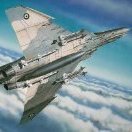Leaderboard
Popular Content
Showing content with the highest reputation on 03/21/2024 in Posts
-

Tamiya F-16 Aggressor, Kicked Up a Notch, May 10: Clear Gloss Coat
Azgaron and 11 others reacted to chuck540z3 for a topic
Thanks Guys! Thanks Mike, it's great to see you follow along again. Sorry to hear about your friend. That's brutal. Thankfully after lots of CT Scans and the like, I don't have anything sinister going on, but without going into too much detail, I do have lots of scar tissue due to multiple stomach surgeries after an ordinary appendix removal 3 years ago. Just bad luck I guess, so we'll see what the future holds for more trips. I liked your "work smarter, not harder" comment, which I used again at the end of this update. March 21/24 First a little housekeeping. I showed above that there are 3 blue hydraulic lines that stick out a bit at the front of the main landing gear, so I tried to create something that was close. It turns out I have a pic of them, so here they are below. Duane (chaos07) pointed out above some slight depressions near the canopy hinge, so here’s a pic of the one on the left. It has since been filled, along with the one on the right. Thanks Duane! The kit parts share many with the Block 50 kit, so some of them need to be modified. Although the blister removal on the wing roots is in the instructions, here they are again, since they are easily missed. Here’s a tip that helped me a lot. The instructions have you join the upper fuselage Part B28 to the rear upper fuselage Part A1 in Step 19 first, then glue the entire upper assembly to the lower fuselage in Step 20. While this kit is generally excellent, gluing such large mating surfaces all at once is asking for trouble in my mind. Instead, I glued the rear Part A1 to the lower fuselage first, got things sorted out, allowing the glue to dry and cleaned up, then glued the front Part B-28 to the rest later. This procedure allowed me to glue all the complicated fitments in a reasonable amount of time without being rushed. Gluing one big upper assembly to the lower assembly as instructed, would have been very hard to do cleanly. I find masking off cockpits and landing gear to be a real PITA, partly because its hard to do cleanly, but also because it must be done right if you want a successful outcome. There are no real shortcuts, but I have developed a procedure that I’m sure a lot of you guys use as well. Note that this model is now sitting on the same cardboard box I’ve used for at least 6 different models, using pipe insulation as a soft platform. The yellow paint is from my Harvard/Texan build 4 years ago, followed by my Special Hobby Tempest Mk V, Italeri CF-104 and my last build of the big 1/24 Airfix F6F-5 Hellcat, which all sat on this same box for much of their assembly and painting. More on that in a bit. I used a small block of foam to fill the cockpit cavity, then ordinary masking tape for the rest, followed by a liberal coat of liquid mask. The mask holds everything together strongly and covers small edges that tape won’t adhere to. When the liquid mask has dried, I apply a few pieces of masking tape, since the liquid mask is tacky and you don’t want it to stick to anything and come off. The landing gear bays were a lot harder to do, but I did have the advantage of having a central beam to attach masking materials to, since Part C27 will not be installed until the end of the build, right after the landing gear is installed. Again, the voids were filled with custom cut little pieces of foam, followed by masking tape. Everything was then toughened up with liquid mask, in this case “Mr Masking Sol neo”, made by Mr. Hobby in Japan. This is the very best liquid mask I have found, because it’s easy to apply but more importantly, easy to remove as well. You can’t say that about Micro Mask, which can be almost impossible to remove from small cavities after it dries. Again, cover tape to keep the gear bays from sticking to stuff, like my fingers, arms and elbows as I handle the model. As much as my cardboard modeling box has served me well for a long time, it was time to “upgrade to a new model”. This was created with a small acrylic storage container that was 6 ½” X 12”, cut down to 2 ½” high, then foam pipe insulation was added to the top, for a total cost of about $3. While I see that many of you use all sorts of contraptions to hold your models, I like this simple box a lot better. There are no pressure points to rub paint, I don’t have to adjust anything and I can carry my model around safely to and from my paint booth without fear of it falling off something. I just cover the box with a microfiber towel and paint away. You can flip the model around from top to bottom with ease, because there’s always a position somewhere that fits. One thing I’ve noticed in my pics above is that the leading edge flaps are usually up a bit when parked. According to Jake’s book, this is normal for parked Vipers, which are up about 2 degrees, so I will be gluing the flaps accordingly. Right now they are just dry fit. The other thing I found in Jake’s book and pointed out by Pete Fleischmann earlier, is that Block 25/30/32 jets have only 2 “fingers” that connect the flaps to the wing at the most inboard position. This kit has 3 fingers, just like the Block 50 kit, so it’s obviously a holdover not easily cut off like the blisters. If I filled the outboard finger it would be more accurate, but I’m not sure if this is “working smarter or harder”, since I kind of like the look of it, even if it’s wrong. I’ll think about it. Any thoughts? One thing that I did add was the so-called “ECS Exhaust”, which was basically missing from this kit. What prompted me to look for it, was because there was a small depression at this location, that I thought might be a flaw of the plastic. Checking my Block 50 kit, it’s much more pronounced, although quite small. There’s a great picture of it on Page 65 of Jake’s book with a half shroud forward from the hole in the fuselage, so I fashioned something similar out of styrene. So that’s about it for now. I still have lots to do and then there’s that super complicated paint job! I sure hope it turns out OK. Cheers, Chuck12 points -
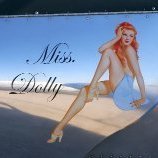
Another Mossie flies again after 70 years.
JeepsGunsTanks and 10 others reacted to LSP_Ron for a topic
11 points -
Just in from Laminar Flow Design: The contents look amazing! I'll be doing an in-box review soon. Kev10 points
-

Revell 1/24 N-1 Starfighter
Greg W and 9 others reacted to The Madhatter for a topic
It polished out nicely on the bottom! I should be able to get the same, if not a better result for the top half. It's hard to photo in the sun as its so shiny but you get the gist10 points -

Welsh Models 757 Iron Maiden
D.B. Andrus and 7 others reacted to LSP_Kevin for a topic
While it might not look like it, quite a lot of work has gone into this one since the last update. Mostly filling, sanding, and priming! The cabin windows are mostly sorted now: I've also finished with the wing box on the underside: And that leaves just the awful forward section of the wing roots to take care of: Here's a reminder of what the real thing looks like: I don't plan to replicate this on the model, as it's just too much work, and perhaps not even really possible. Instead, I just plan to bulk out the area with some Milliput, such that it will take with wing root light and not look silly. The engines on this livery are blue, like so: So I used the kit engines as a testbed, and sprayed some Tamiya X-4 blue enamel to see what it looks like: Close, and perhaps good enough, but certainly not an exact match. The real colour seems slightly lighter, and perhaps a touch more towards purple - but I don't really have much of an eye for these things. I've got plenty of time to experiment, however! That's all for now. Thanks as always for checking in! Kev8 points -
Kawanishi N1K2-J done!
levier and 6 others reacted to Chuzam Naj for a topic
Done after 3 months. While taking photos yesterday, I noticed that the undercarriage extension indicators were missing. My next project will be Curtiss P-40N Milkyway Wagon/Please Daddy.7 points -
Macchi Fighters book.....Oh, my!
Rick Griewski and 6 others reacted to paul fisher for a topic
Not really sure where to put this as I've never reviewed a product before but the new book from Crecy on the Macchi 200, 202 and 205 fighters arrived yesterday and simply blew me out of my socks.I was deeply into building Italian aircraft in 1/72 scale back in the 70's and 80's when I could see that well and lately my interest in trying again in a larger scale has been growing so I went ahead and bought this book. We had nothing even remotely this good to go from and the Italian publications of the day suffered from poor photo reproduction and paper. I was pleasantly surprised at the depth of detailed information, drawings and best of all clear period photos that really show the design and construction of these beautiful 'planes .One thing I note in particular is that none of the paint applications are the same from 'plane to 'plane, even in the same scheme the motions of the human arm and hand are visible in the random application of the markings.A feast for the smoke ring aficionado.I am already searching for a better airbrush! Since losing a fifty year accumulation of books a few years ago I have been extremely picky about what I have replaced.This is certainly a book worth the modest price and I highly recommend it to anyone wanting to know more about these gorgeous aircraft. Best, Paul7 points -

1:32 Hawker Siddeley Andover E.Mk 3A - 3D Print
patricksparks and 6 others reacted to Iain for a topic
Appear to be on a bit of a Mojo roll with a number of projects just now - including the Andover. Final priming/sanding of fuselage interior pretty well done now - and progressing on to the paint colours - white, light blue and grey. And tail: Blue skies, Iain7 points -
*** Finished*** 1/32 Trumpeter P-47D-22 "Kansas Tornado"
LSP_K2 and 5 others reacted to Tolga ULGUR for a topic
Some progress:6 points -

Malvinas Dagger
BradG and 5 others reacted to blackbetty for a topic
before joining the halves i made some intake trunking in bolth halves to prevent a see-through fuselage granted, the mirage intakes are very small, but still a modification i wanted to do6 points -

Silver Wings Fokker D.XXI
Rick Griewski and 5 others reacted to LSP_Kevin for a topic
Including spaces, but not the quotes, "Silver Wings Fokker D.XXI" contains 25 characters. Kev6 points -
Interior mostly painted and weathered. I kept weathering to a minimum. That was hard. … Kelik 3D printed instruments are a joy to use and fit perfectly. Andreas6 points
-

Another Mossie flies again after 70 years.
Christa and 4 others reacted to Troy Molitor for a topic
This is the fourth one they have built. What an accomplishment. Love the sound and looks of the Mossie in flight.5 points -
Another two mossies on the way- one for Peter Monk at Biggin Hill and another for The People's Mosquito. Great times ahead.5 points
-
Silver bits are now done! I'll need to mask them off ready for the next colours, so I'll let the paint cure at least overnight before laying any tape on it. Kev5 points
-
Another Mossie flies again after 70 years.
JeepsGunsTanks and 4 others reacted to Christa for a topic
Paddling a KW 7 kayak on the River Dee above Chester, England, one evening in Spring 1969, I was startled when a Mosquito flew low over the river. I didn't capsize, but it was close! That beautiful aircraft was an unforgettable sight, sound and surprise. Years later I learned my pal, Keith 'Kipper' Davies, was aboard the Mosquito that evening. Kipper was an instrument technician based at Hawarden. He had volunteered his services for the Mosquito in return for some flights. Wonderful to see another Mosquito take to the air.5 points -

HK Models Bristol Beaufighter?
Paul in Napier and 4 others reacted to Iain for a topic
The only potentially flyable one I'm aware of Paul is the restoration to flying condition being undertaken by The Fighter Collection at Duxford - that's been a very long-term project having watched it slowly progress over the years. I'm not sure what the latest news is on it... EDIT: There was a fairly recent update on their Facebook page - Dec '23 - of them working on her still - so still promising. https://www.facebook.com/photo?fbid=742211257943473&set=a.547708264060441&locale=en_GB Iain5 points -
Thanks for looking and for your messages. I'm thinking of trying on a mule for this BB'ing of the rather unusual wings. I preferred to take care of the green and red formation lights before continuing with the camouflage. The transparent parts are really too big. So I drilled them out on the inside with a 0.5mm drill bit, then applied a little translucent green and red paint. Then I glued these 2 pieces together with 5mn bi-component epoxy glue to ensure a very solid bond for the sanding to come. I let the glue dry overnight and then shaped and polished these formation lights with Micro Mesch 2500 => 12000. As it wasn't perfect yet, I had to apply a little putty to get the light/wing junction just right.4 points
-
Hello guys, before answering one by one, sorry for the delay, some personal things have required my attention and I have not been able to make much progress, as for the radar cone, the tape simply played tricks on me but it is now repaired As for the exterior panels, they are from the same kit, I simply taped it with mask and painted it with Alclad II Steel, as for the support, the one I have is for 1:48 scale but it works for 1:32 perfectly, I personally recommend that I buy The one I have is a little flimsy and bad, it cost me 25 euros, there are much better plastic ones and it is not necessary to assemble it like mine, it is made of poor quality "wood", if you buy a support buy for scale 1: 32 that will serve you for the 1:32 and 1:48 scales I recommend this one https://ak-interactive.com/es/producto/aircraft-holder-large-msj03/ Thank you for your kind words, I do what I can with what I have, now you will see that the anti-slip decals are a little broken, right? They are placed on purpose so that they will serve as templates for the mig jimenez anti-slip, to simulate the lateral anti-slip In my case, my military life... I served 6 years, of that 6 years I had 3 detachments in Afghanistan, 2 for 6 months, 1 for 4, 6 years of my life I never set foot in my house, neither on Christmas nor on new year, nothing, you understand me. As for my friend, he is from the new batch, that is... he graduated from the general air academy and went directly to Eurofighter (officer school and obtained the cut-off mark for the combat pilot specialty, that is, in Spain goes by specialty) That is to say, the first 5 in promotion are those who have gotten the best grade and decide whether to be a fighter pilot, helicopter pilot, etc. The specialties would be: Fighter pilot Transport pilot (propeller) Helicopter pilot and those who do not choose to be pilots go as officers to the units they want, special forces, infantry, etc. Other pilots who flew the C15 (in this case our F18 are CASA 15 (C.15 Single Seat and CE.15 Two Seater) have never spoken badly about the F18 and even more so with the EADS improvements, but many took the transition course to the Eurofighter, I think they are going to Germany to do the training and they say that it is a delightful machine, really all combat fighters are a damn marvel haha and you know it very well, as for the eurofighter the differences are in the interface of the instruments, Obviously the Eurofighter is more modern and is in progress, the difference is that production is divided into three models or phases with a gradual increase in capacity in each of them. What happens in Spain is that we have few planes and many fighter pilots, they rotate among them The F18 that we have are destined for the Canary Islands are ex-USNavy, as a curious fact, the others were purchased at the time from the former McDonnell Douglas (now Boeing4 points
-

Malvinas Dagger
themongoose and 3 others reacted to blackbetty for a topic
then i cut a wedge from both fuselage halves behind the cockpit to make the italeri bulkhead fit4 points -
While I actually have the old kit in the stash, along with a ton of legacy aftermarket for it, with plans to do what I can with it, for people more sane than I am, I'd recommend grabbing a Dragon kit (or the Revell rebox), and sourcing one of the AIMS conversion sets. This will give you a better result with arguably less effort, but at probably significantly more cost. Kev4 points
-
Happy Birthday Peter!
mozart and 3 others reacted to europapete for a topic
Hi Brian, Will do, I REALLY should master the pic posting anyway. oh yes, 63, if anyone was wondering.4 points -
I can absolutely relate to almost *every* word of that Denzil! Apart from the Global stash bit - my two stashes are only 50 miles apart... Iain4 points
-
.thumb.jpg.5da8bff9741de420eb2e87addd8f2cf6.jpg)
Models in the closet
europapete and 3 others reacted to RadBaron for a topic
Well said by all, and I think we're all bitten by the same bug. In an effort to attempt to hold back from simply buying everything that looked cool, (and in attempt to fit things in the cabinets) I've restrained myself to buying only specific topics in specific scales, and difficult to find/rare kits. Which hasn't worked at all to quash ridiculous amounts of buying, if anything now that purchases are subjects close to my heart, it makes them harder to part with every time a purge is considered. And, as can be attested on this very sight, my Build/Buy ration is somewhere in the realm of 1/100. So to build what I already have will take approximately the same time as the latent heat death of the sun, let alone what I'm yet to buy. And let's not mention the stash on the OTHER side of the planet... AND this isn't even taking into account the other time consuming hobbies. Totally a first-world problem, no doubt, but we're in in good company. And at least it keeps us off the streets! Denzil4 points -

1:32nd scale Halberstadt D.II
denders and 3 others reacted to sandbagger for a topic
Hi all, This the pilot figure from 'Aviattic. I replaced the head from my 'spares', as the original seemed too small. Painted with 'Tamiya', 'AK Interactive' and Citadel paints. Weathered with 'Flory Models' clay wash (Dark Dirt) and 'Tamiya' Weathering Master (Set D -Oil Stain) and (Set A - Mud). Mike4 points -
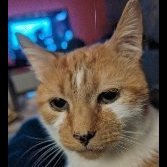
Italeri 1/32 F-104A Starfighter
F`s are my favs and 2 others reacted to Ginja Ninja for a topic
"I, I just took a ride in a silver machine And I'm still feeling mean Do you want to ride See yourself going by The other side of the sky I've got a silver machine It flies Sideways through time It's an electric line To your zodiac sign I've got a silver machine I've got a silver machine I've got a silver machine" Hawkwind - 1971 To celebrate 25 years of LSP I will be building this iconic aircraft from the Cold War which has a myriad of nicknames, some of them defining the sheer speed and others the lethality to the enemy, or pilot flying the aircraft: zipper; missile with a man in it; witwenmacher "widow maker" (Bundesluftwaffe nickname); flying coffin; Ground Nail; Bullet & Blades; Badmash "wicked one" (Pakistani nickname for F-104As); Eiko "Glory" (Japanese nickname for F-104Js); spaghetti Starfighter (Italian nickname for F-104S-ASAs.) The kit The AM I hope to start this as soon as I get the fuselage of the AIrfix Spitfire together, but then again I may start tomorrow as I'm rather looking forward to building one of my favourite aircraft. Thanks for looking and happy modelling! Jeremy3 points -
Here I am showing my Williams Bros Gee Bee R-1 which I have just finished after several years on the shelf of delay. It depicts the 1932 Thompson Trophy winner and was flown by Jimmy Doolittle. It's made OOB except for the propeller hub, which I remade from aluminum. I did not include the thin black pinstripes separating the red and white colors as I could not think of a way to produce them in scale. The pilot figure is from Immense Miniatures.3 points
-
Kawanishi N1K2-J done!
levier and 2 others reacted to Chuzam Naj for a topic
More photos for Jaro....3 points -
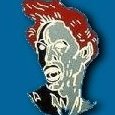
Hasegawa FW-190D "Late Version"
Troy Molitor and 2 others reacted to Furie for a topic
The image doesn't display, but anyway, if it's not a photo of the real plane... It's the lack of a photo of the late version D-9 that made me not buy this kit. By the way, it makes you wonder where the color profile designers got their information from. You'd think they were copying each other.3 points -

Make the others jealous
dutik and 2 others reacted to BloorwestSiR for a topic
I stopped by my LHS yesterday during a quick break at work. They had a few kits set aside for me so I was happy to pick them up. The YF-22 is for a project I'm working on, I need the burner cans/nozzles from it. I'm hoping they'll save me a some scratch building. The Fisher kits came in from a large collection of mostly 1/32 kits. They knew I was interested in them so they generously held them for me and gave me first crack once they had a price. Nendless to say it's most I've spent in my LHS in a long time. It's also one of the things that makes me glad to have a great LHS. Carl3 points -
1/32 Kotare conversion; Supermarine Spitfire LF Mk.Vb YO-A 401 Sqn RCAF.
duke_ and 2 others reacted to monthebiff for a topic
Managed to complete the cockpit assembly today, first up was adding the HGW seatbelts and then fit the Barracudacast plastic seat and armoured backrest to the Kotare frame and then the Barracudacast late control column to the footboards as well as adding straps to the pedals And the rest of the sub assemblies prior to assembly And the cockpit tub together Time to get the fuselage together now and then concentrate on finishing the wing conversion. Regards. Andy3 points -
My bad, sometimes my really awesome sense of humor doesn't translate well on social media / online forums. I wasn't trying to slag the mods, just trying (and apparently failing miserably) to be witty. All good at my end, apologies for the snarky response. Keep up the good work.2 points
-
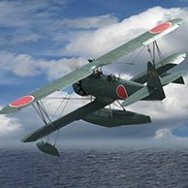
Me-110?
monthebiff and one other reacted to denders for a topic
The G-4 conversion seems to sell out pretty quickly once it's back in stock.2 points -

Tamiya F-16 Aggressor, Kicked Up a Notch, May 10: Clear Gloss Coat
Azgaron and one other reacted to chuck540z3 for a topic
Thanks Bevan! March 21/24 Another quick update while a few things are still clear in my old mind. Whether to delete one of the front flap “fingers” has bugged me since I made my post above last night. While I always strive to make my models as accurate as possible, sometimes the effort isn’t worth the reward and in some cases, altering things can look worse, so you wish you hadn’t bothered. One thing that I wanted to do was to leave off the front flaps until after painting, so that I could easily mask off and paint a few small things like the RHAW “beer cans”. If I just glued them on permanently now, however, filling in the gap for the third finger would be fairly easy and I could re-scribe the panel lines. I came very close to doing so…. Before I did that, I thankfully flipped the model over to see what exists for detail underneath. Here there is a lot more detail and none of it would be easy to fill and recreate, because the kit parts are made so that the flaps can be either raised or lowered, leaving a big gap. The real wing doesn’t look like this at all and is almost identical to the top. If it did, I would just fill it, but since it would be a real PITA to modify the kit wing, I’m going to punt and Fuhgeddaboutit! For years I have been a bit intimidated by all the F-16 Block variants and what specific details they should all have, including the reinforcement plates that many of them have. Apparently Block 50 and up variants don’t have them, because they are internal. I have the super thin stick-on set that came with the kit in the upper right, but I also have the thicker Cross Delta set on the left, which thankfully comes with accurate instructions as shown below. This indicates that I should be using the large fuel tank plate which is actually made from 5 parts (1), the “lawnmower blades” around the front of the vertical stabilizer (2), and a fairly big panel around the nose radar blisters (7), which are RAM panels (Radar Absorbant Material). Surprisingly to me, the more modern Block 40/42 Vipers have a lot more reinforcement plates as shown. My subject, 84-1220, nor 86-1229 have the front plates, which are RAM panels, so it looks like I’m good with using just #1 and #2. While digging around for reference photos, I stumbled upon pics of a THIRD F-16 Aggressor painted in the digital Ghost Scheme. It’s another Block 25, 84-1301, and since none of the pics are mine, you can see it here at Jet Photos: F-16 "Ghost" Aggressor, 84-1301 Pretty cool. Cheers, Chuck2 points -
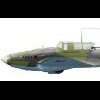
Another Mossie flies again after 70 years.
Archimedes and one other reacted to Learstang for a topic
Built is right. There can't have been much of the wooden components of the original airframe they were able to use. Inevitable with wooden aircraft, I suppose. That's why there are no original LaGG-3s nor La-5s around, flying or otherwise. Still nice to see a rebuilt Mosquito flying, no matter how much of it is original. Regards, Jason2 points -
Thanks, Iain. I'll definitely be sleeping on the colour, and if it looks close enough tomorrow, then it'll do. I should compare the paint to other photos of the aircraft, too, and not rely on just one - even though it's a great close-up shot! The other main area still to be tackled is modifying the engine pylons so that they'll fit the wings. The plan at this stage is still to graft the rear of the kit pylons to the Bra.Z engines, which I can do now that I've finally got the engines themselves sorted out. Lots of filling, scribing, and sanding there too! Kev2 points
-
That looks great Kev - going to be a great canvas for the paint once you've sorted the wing roots... That blue looks pretty good to my eyes - at least allowing for variation between screens - and objects photographed in differing lights. Iain2 points
-
2 points
-

Me-110?
Archimedes and one other reacted to thierry laurent for a topic
Well, if you have six months of available time and a lot of documentation... https://www.largescaleplanes.com/articles/article.php?aid=3093 Even if far from simple or cheap, the Dragon/AIMS combination will put your model in another league!2 points -
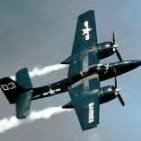
HK Models Bristol Beaufighter?
scvrobeson and one other reacted to Out2gtcha for a topic
Just now catching up with all this...... Having a Lodela BF and having invested in the MM Beau interior parts I'm still a bit befuttled with the potential release of a new tool Beau, but I would 100% buy one from HK.2 points -

HK Models Bristol Beaufighter?
Paul in Napier and one other reacted to Iain for a topic
Actually - I was wrong - there *may* be two airworthy Beaufighters on the horizon - with a second one at HARS in Australia! http://www.warbirdsonline.com.au/2019/06/10/beaufighter-engine-restoration-news/ Iain2 points -
Looks amazing, Si! You ever get one of those builds where the worst possible thing will happen at the absolute worst time? I'm still waiting for a build where this doesn't happen! Kev2 points
-
All military service is worthy of respect - we all know just how much we sacrificed to live that life. I say 'live the life' because it is a life, not just a job anyone does, and all roles are important. I must say there are many military jobs I wouldn't want to do, and I consider myself privileged to have done what I did. I'm curious - has your Eurofighter pilot friend also flown Hornets? What does he think of the comparison between the two? I'm loving your attention to detail on the exterior. This is a fantastic kit, and a good modeller can really do it justice (like you). The weathering in the gear bays is looking quite realistic, as are the screens. I suspect they are simply the ones moulded on the kit, but nicely painted. I did a cockpit with colour PE on the same kit. I think yours looks better. ALF2 points
-
Tamiya 1/32 F4U-1 Corsair
SwissFighters and one other reacted to Nikola Topalov for a topic
I am using AM open cowl flaps and I found some room for slight improvement by adding flap mechanism cables made from stretched sprue:2 points -

HK Models Bristol Beaufighter?
Rick Griewski and one other reacted to Palm-tree for a topic
Neil could have pointed his scanner at anything just to throw everyone off the scent? Even if he set it up in the gift shop the inevitable wishlist would appear.2 points -
HK Models Bristol Beaufighter?
Phartycr0c and one other reacted to Finn for a topic
No they aren't doing the Beaufighter, they are just scanning the engines so they can come out with a Lancaster MK. II. Jari2 points -
After a winter of bad weather, work has started again on the Lightning. Multiple paint corrections are in the process of being carried out. One problem that occurred after stripping the pitot probe of paint was that it broke in half through fatigue cracking - Trumpeter plastic seems to react in strange ways to glued and thinners. The upshot was that it was unrepairable due to its thin cross-section (I tried, and it failed again). I had no option but to make a new one. This I did by cutting a length of 1.6 mm diameter aluminum rod and filing and sanding it to shape (The length of the pilot probe in 1/32 scale is 70.3 mm). Derek2 points
-
I also recently put in an Ikea Milsbo cabinet. I also put in the Ikea Skydrag linear, dimmable LED strip light which works quite well for me. Sadly my recently completed 1/32 Stuka won't fit in the cabinet.2 points





